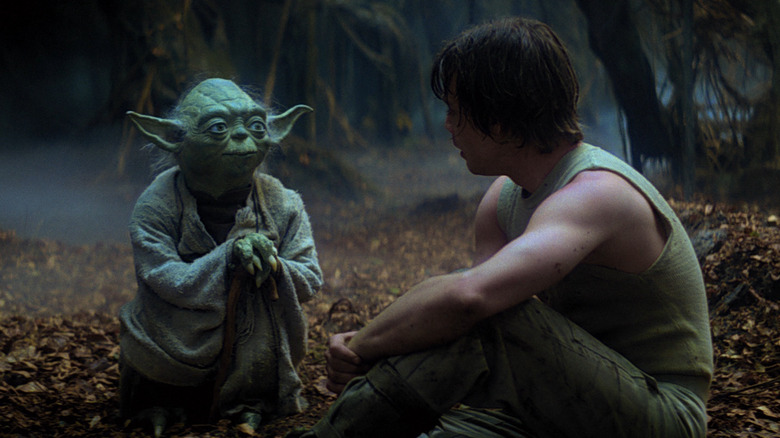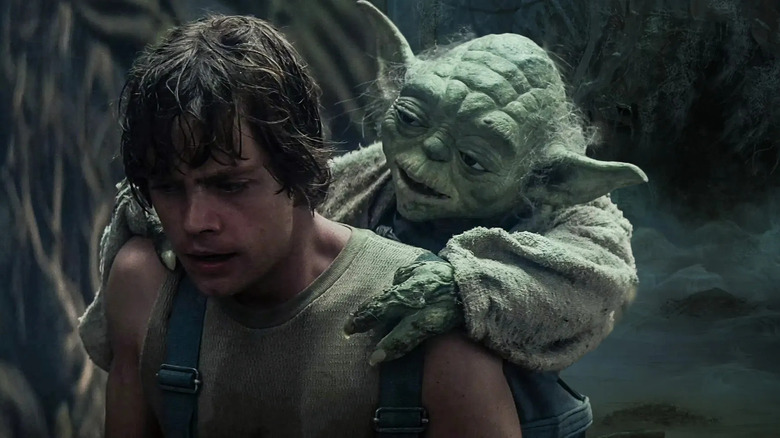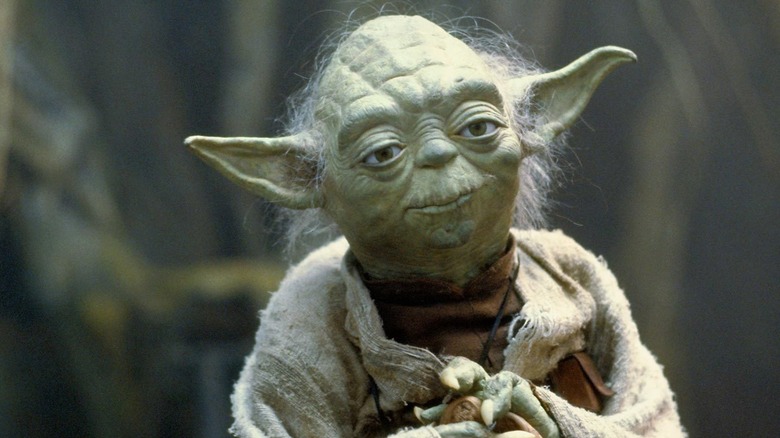It Was A Race To Finish Star Wars' Yoda In Time To Shoot The Empire Strikes Back
Akira Kurosawa's 1975 film "Dersu Uzala," his only film not in Japanese, is about a team of Russian surveyors who are tasked with mapping a portion of the country's eastern wilderness. While on their mission, they come upon a small, elderly man who has been living off the land most of his life. He is peaceful, wise, and possessed of a gentle friendliness. Without much in the way of negotiation, this man, named Dersu Uzala (Maxim Munzuk), takes the Russian surveyors under his wing, and gently instructs them on how to complete their mission in harmony with nature. This involves surviving storms and avoiding trappers.
"Star Wars" creator George Lucas has gone on record with his affection for the films of Kurosawa, and how he based "Star Wars" on elements from Kurosawa's "The Hidden Fortress." Ever since, essayists have expounded extensively on the connection between the two filmmakers. I trust the reader will forgive me for this is very roundabout way of getting onto the topic of Yoda.
Young "Star Wars" fans, perhaps exploring Kurosawa for the first time, may immediately recognize Dersu Uzala as the inspiration for the diminutive Jedi Master as he appeared in Irvin Kershner's "The Empire Strikes Back." Yoda, belonging to an as-yet-unnamed alien species, was first seen living on the distant marsh-covered planet Dagobah. He stood about two and a half feet tall, sported long, goblin-like ears, and was visually realized using a complex puppet operated by voice actor Frank Oz. The puppet itself is detailed and expressive, and the filmmakers outdid themselves making the character convincingly interact with the human-sized character of Luke Skywalker (Mark Hamill).
As detailed in a 2020 retrospective on "Empire," seen on StarWars.com, Lucas talks about how the SFX crew were constructing Yoda literally until the hour before filming.
The first day of shooting
Lucas, while not the director or writer on "Empire," was heavily involved in production. Prior to actual filming, the only exposure Lucas or anyone else had to Yoda was through Oz. While it's true that Lucas had Dersu Uzala in mind, and Oz performing the voice, there was no physical representation of the character yet. The production on Kersher's film was notoriously rushed, with production beginning in January of 1979 and a release date of May 1980. For a big-budget, sci-fi sequel that aimed to out-do its 1977 predecessor, that was a very fast turnaround. Lucas recalled that he didn't really see Yoda in action until shooting actually began. He said:
"I didn't really understand it until the first day of shooting, and seeing the dailies and seeing it in action and under the right lighting conditions. [...] A lot of those things, like Yoda, got finished like an hour before we shot it. Everything was always on the run. So I finally got to see the whole thing finished, put together, lit properly, and that's when I knew it was going to work. Before that I had to rely on Frank Oz."
Yoda was ultimately designed largely by makeup artist Stuart Freeborn, which he based on a combination of Albert Einstein and on his own face. Freeborn also worked on the makeup for "2001: A Space Odyssey," "Dr. Strangelove," "Return of the Jedi" (he helped design Jabba the Hutt), and four "Superman" movies. Lucas was careful to credit Freeborn's work, saying:
"Frank had performed great in rehearsals and Stuart Freeborn was working very diligently on trying to get the puppet to work, but it didn't convince me until I saw the actual movie."
Luckily, he — along with most audiences — was convinced.
It all relied on Yoda
Yoda was vital to the storytelling success of "The Empire Strikes Back." Kershner's film largely follows two simultaneous story paths, with the B-plot following Han Solo's space flight away from the pursuing Empire, and the A-plot following Luke to learn about the mystical Jedi arts from Yoda. The A-plot contains a lot of spiritual and dramatic heft as Luke faces demons and falters in his psychic training. If Yoda wasn't convincing as an actual being with wisdom and authority, the story wouldn't work. Lucas knew this, saying:
"If it hadn't worked, obviously the movie would have been terrible [...] It would have never worked ... And you don't really know until you actually show it to an audience and they don't get up and storm out and say 'This is stupid.'"
While there were voices in popular culture that mocked the Muppet-like appearance of Yoda — "Weird Al" Yankovic and MAD Magazine certainly had a field day with the character — a general audience consensus seems to have emerged that Yoda looked just fine, and that the character was to be celebrated. To this day, one can find Yoda merchandise on toy store shelves, and the character returned for "Return of the Jedi," several "Star Wars" prequels/sequels, and multiple TV shows.
By any measure, Lucas, Kershner, Oz, and Freeborn created a lasting character that soaked deeply into the pop culture firmament.
Now if only someone would give his species a name.


